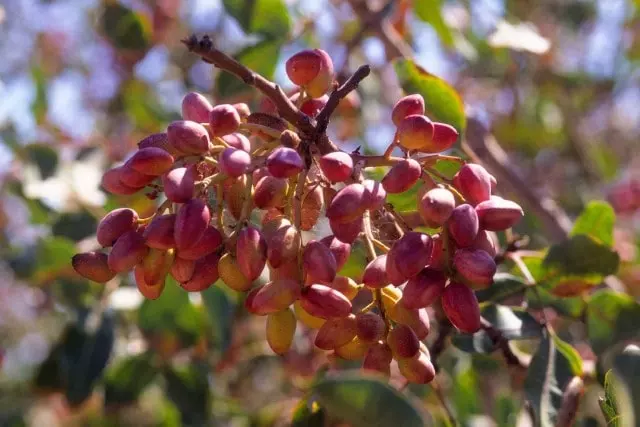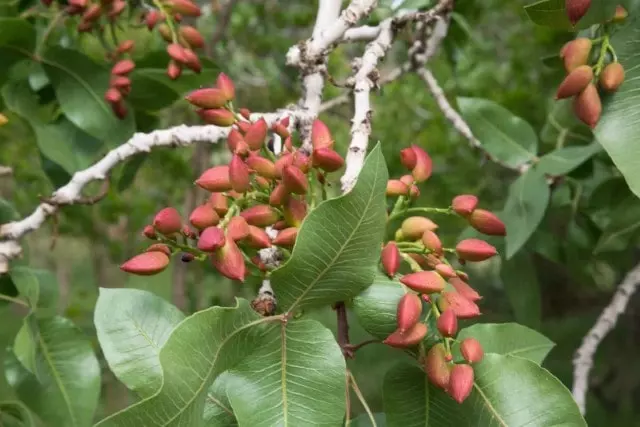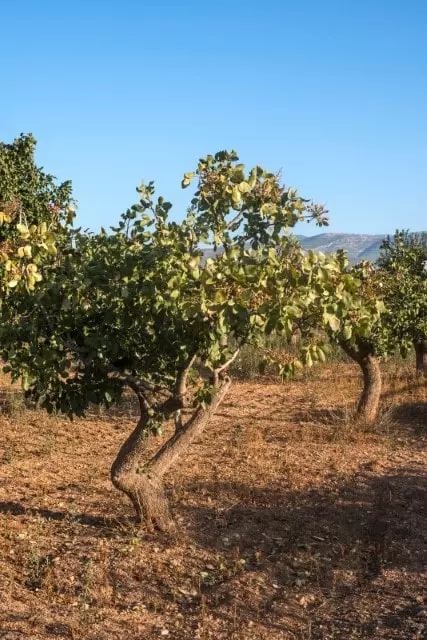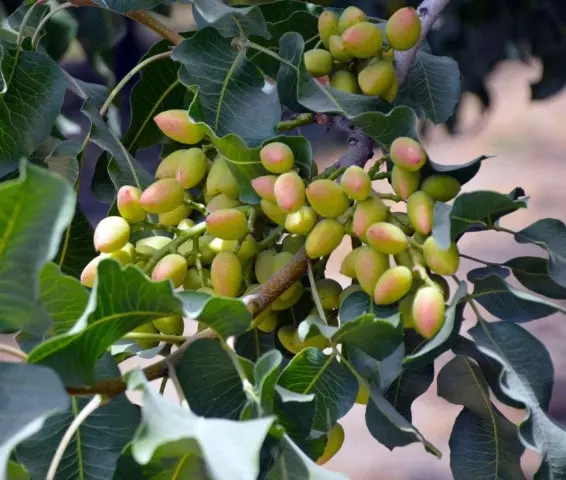The pistachio is a tree whose scientific name is Pistacia vera L., Anacardiaceae, which produces a variety of nuts that is very well known today, not only for its low amount of calories but also for being very rich in phytosterols, antioxidants, unsaturated fats (the good stuff), carotenoids, vitamins and minerals, fiber and delicious flavor. If these aren’t enough reasons for you to want to figure out how to grow pistachios indoors, I don’t know what else will.
Growing a pistachio tree outdoors can be a bit tricky at first (when the plant is small). Therefore, in this article, we will explain how to grow pistachios indoors so that they grow healthy and strong.
There are currently 11 species of pistachio cultivated, but only the Pistacia vera tree is commercially cultivated. The origin of pistachio trees is still unknown, but there are indications that it was in Central Asia. The main producers of pistachio cultivation for export are Turkey, Iran, Afghanistan, Italy, and Syria, all being suitable countries for its growth due to their arid climate.
Table of Contents
Tips To Keep in Mind on How to Grow Pistachios Indoors
We are interested in growing pistachios indoors so that they grow protected in the first stage of their life when they are more susceptible to changes in climate or drought. The following tips apply to growing pistachios both indoors and outdoors.
Les’s see requirements we will need for growing pistachios indoors.
When To Grow Pistachios Indoors
When To Grow Pistachios Indoors? The climate is crucial when it comes to growing pistachios indoors; since the ideal temperature is above 100 °F (38°) C at least during the day. In addition to needing winters with enough cold to complete its dormant period, with a temperature of 45 °F (7° C) or less, you must keep in mind when it comes to how to plant pistachio that your tree does not do very well at high elevations where temperatures are very cool or anywhere where temperatures drop below 48 °F (9° C).

Soil Used for Pistachio Trees
Pistachios tree can be a bit demanding when it comes to temperatures, but quite the contrary when it comes to the soil where it is going to be grown, growing well in any type of soil, however, if you want to have higher productivity, a secret on how to grow pistachios indoors is to use a sandy or sandy loam soil. It should also be well-drained soil.
Watering The Pistachio Plant
Pistachio trees should be watered infrequently, if possible, as these trees are quite a drought-tolerant, quite the opposite with moisture.
How to Grow Pistachios Indoors Step by Step
How to Grow Pistachios Indoors? Pistachio seeds to germinate need to go through a cold stratification process. This means that we will need to simulate that this process takes place in winter as in nature.
To grow pistachios indoors the first thing we need to do is germinate the pistachio seeds, roasted pistachio seeds are not suitable for germination. Use a bowl of room-temperature water and soak the seeds for 48 hours.
Wrap the pistachio seeds in a small towel and store them in the refrigerator (cold stratification) for at least 45 days. To achieve germination of the pistachio seeds, the towel should be kept moist for this number of days. We recommend adding a little cinnamon powder to the pistachio seeds to prevent fungal growth.
Once the period has elapsed, remove the towel from the refrigerator and plant the pistachio seeds in pots. Pistachio pots for growing pistachios indoors should be at least 6” (15 cm) wide.
The temperature of the area you have chosen to grow pistachios indoors must be between 68 and 86 °F (20º to 30ºC), so it will be easier for the pistachio seeds to develop properly.

How to Grow Pistachios Indoors by Cuttings
Another option for growing pistachios indoors is by cuttings, this option is faster than seeds. Growing pistachio cuttings indoors ensures that they are protected from temperature changes.
1- Select a branch of a pistachio tree that is not too thick. Then we will cut it with sharp and disinfected pruning shears (to prevent diseases).
2- Apply some cinnamon and rooting hormone to the pistachio tree cutting.
3- Place the pistachio cuttings in a well-drained substrate with a pH between 6.0 and 8.0.
4- The ideal is to plant pistachios between the end of spring and the beginning of summer.
By following these simple steps, you will be able to grow pistachios indoors successfully.
- FASTEST ROOTING POWDER FOR PLANT CUTTINGS: Hormex rooting hormone powder is a unique product that encourages the natural process of rooting new plants from cuttings. Please check the list of plant varieties and rooting powder strength in the product photos.
- SUITABLE FOR ALL GROW MEDIUMS: Accelerate strong and healthy roots with this root stimulator for plants that are excellent for all grow mediums like Rockwool, coco, peat moss, soil, clay pellets, and more. As an added bonus, it also helps prevent root rot and sagging cuttings.
- NO BAD STUFF: Our root hormone for cuttings is an excellent powder to use even on the toughest and hard-to-root plants, like juniper, grapes, tomatoes, and more. It is made with no alcohol, dye, or preservatives, which is especially important when plants are for consumption.
Pistachio Tree Care
Pistachio nut trees are long-lived, have a very long root system, and can grow 20 to 30 feet (6 to 9 meters) tall. You should start by planting the seedlings in small containers for the first three to five years and then transplanting them into the garden.
Pruning Pistachio Trees
Since pistachio trees are classified as fruit trees, pruning is an important part of achieving higher fruit production and better quality, as well as controlling their growth. In the case of young trees, you should select three to five branches that will be the main structure of your pistachio tree in April, the first growing season. You should choose those that have a similar spacing for the trunk, but not in front of each other with a height of 24 to 32 inches (60 to 82 cm) above the ground, cutting the branches that are below these.
Subsequently, you should remove those upper branches that can be a shadow for the trunk of the tree and tighten those that are not part of the main structure about 4-6 inches (10-15 cm) from the trunk. Later in June, you can prune the structural branches to 2 to 3 feet (0.6 to 0.9 meters) in length to promote growth, while leaving the side branches to provide more shade to the trunk as it grows.
The central open center structure should be kept open as the tree grows taller by picking out the secondary structural branches. It is possible to prune pistachio trees two to three times a year, with summer pruning being done in the spring and summer pruning in the fall.

How Long Does it take for a Pistachio Tree to Produce
The pistachio tree is a type of tree that takes a few years to start production. In general, pistachio trees begin to produce in the third or fourth year, although maximum production begins in the eighth year.
The productive life of the pistachio tree is very long, in many plantations, it exceeds 50 years.
Fertilizing Pistachio Tree
Nitrogen is the main element necessary for proper shoot growth and good yields of the pistachio tree. Nitrogen deficiencies often result in excessive defoliation during the productive period and, therefore, a decrease in yield. If a nitrogen deficiency is diagnosed, we should apply pistachio planting fertilizer N-P-K 32-0-0 through the irrigation system at an increasing rate each year as the trees mature.
- Powerful Formula: Hi-Nitrogen Kelp-Humic Blend 32-0-0 contains organic Kelp and Humic for greater nutrient uptake and health, perfect for all grass types
- Promotes Healthy Lawn: 32-0-0 nutrient balance promotes quick greening and growth, suitable for nitrogen-deficient turf suffering from yellowing leaves, light green color, thin density, and slow growth.
- High-Quality Material: Green Magic is made with top-quality ingredients that provide superior nutrition for the best growth and health of your lawn.
How to Harvest Pistachios
How to Harvest Pistachios? To know when pistachios are ripe, we must pay attention to the change in color of the epicarp or outer shell of the fruit, which changes from green to ivory and from this pink. While the fruit remains on the tree, this envelope will cover the shell.
If we observe an absence of color changes in this envelope indicates that we are dealing with empty fruit.
As the fruit ripens, the skin becomes translucent to opaque and its envelope is easily separated from the peel with simple and gentle pressure with the index finger and thumb on the sides of the fruit.
The optimum time to harvest pistachios is when the outer covering of the shell comes off fairly easily.




